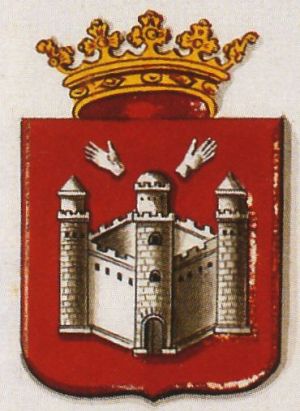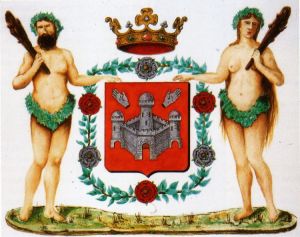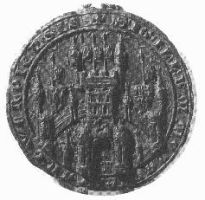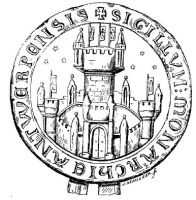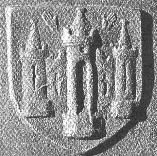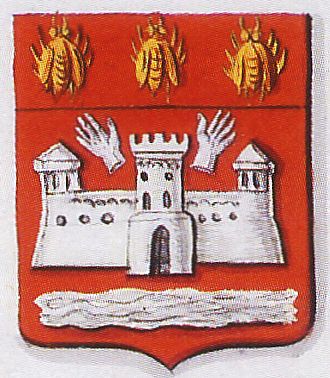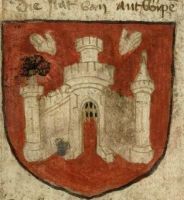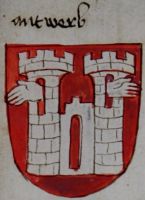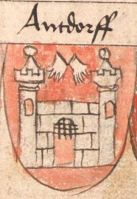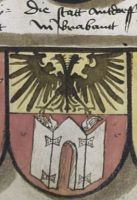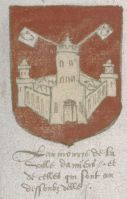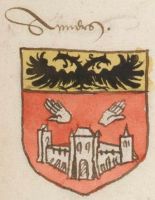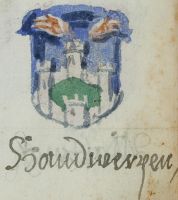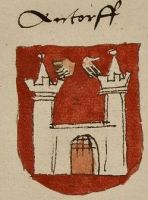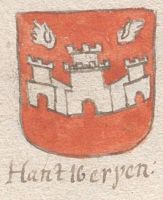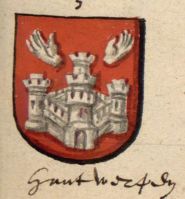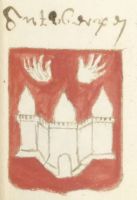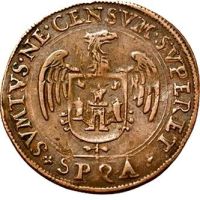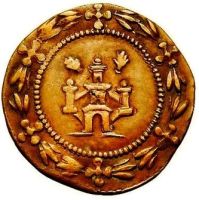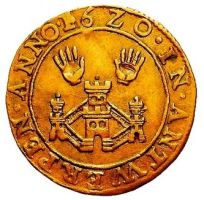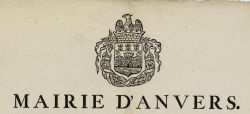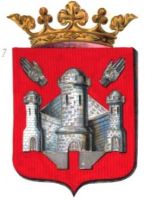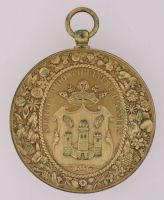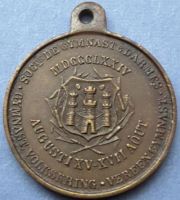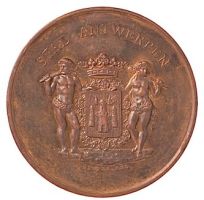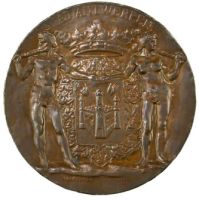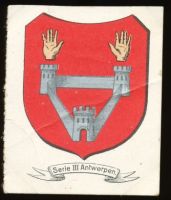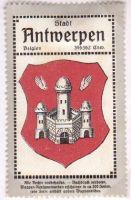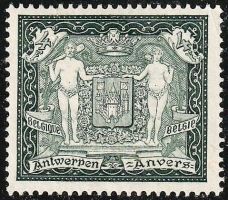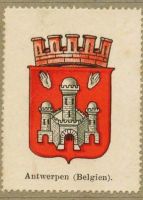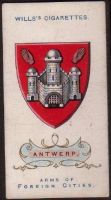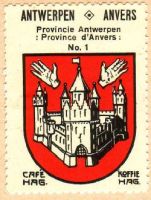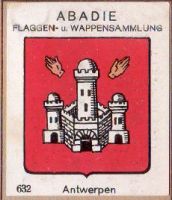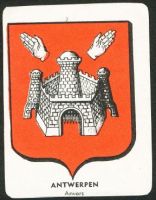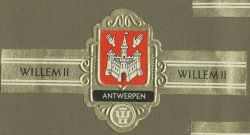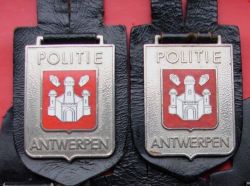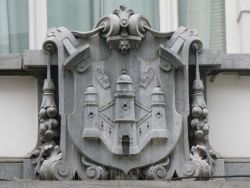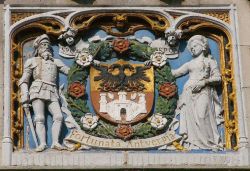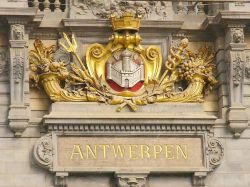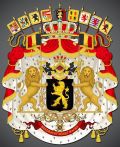Antwerpen: Difference between revisions
Knorrepoes (talk | contribs) m (Text replacement - "|Wapen van {{PAGENAME}}" to "|Wapen van {{PAGENAME}} / Arms of {{PAGENAME}}") |
Knorrepoes (talk | contribs) |
||
| (31 intermediate revisions by the same user not shown) | |||
| Line 1: | Line 1: | ||
{ | {| class="wikitable" | ||
Province : [[Antwerpen (provincie)|Antwerpen]]<br | |- style="vertical-align:top;" | ||
Additions : 1929 [[Oorderen]] | |[[File:antwerpen1818.jpg|center|300 px|alt=Wapen van {{PAGENAME}}/Arms (crest) of {{PAGENAME}}]]<center>The arms from 1818</center>[[File:antwerpe.jpg|center|300 px|alt=Wapen van {{PAGENAME}}/Arms (crest) of {{PAGENAME}}]]<center>The arms from 1881/1985</center> | ||
| | |||
<center>''' {{uc:{{PAGENAME}}}} '''</center><br> | |||
'''Country''' : Belgium [[File:Belgium.jpg|60 px|right]]<br><br><br> | |||
'''Province''' : <br>[[Antwerpen (provincie)|Antwerpen]][[File:antwerp3.jpg|60 px|right]]<br><br><br> | |||
'''Additions:''' | |||
* 1929 [[Oorderen]] | |||
* 1929 [[Oosterweel]] | |||
* 1929 [[Wilmarsdonk]] | |||
* 1958 [[Berendrecht]] | |||
* 1958 [[Lillo (Antwerpen)|Lillo]] | |||
* 1958 [[Zandvliet]] | |||
* 1982 [[Berchem (Antwerpen)|Berchem]] | |||
* 1982 [[Borgerhout]] | |||
* 1982 [[Deurne (Antwerpen)|Deurne]] | |||
* 1982 [[Ekeren]] | |||
* 1982 [[Hoboken]] | |||
* 1982 [[Merksem]] | |||
* 1982 [[Wilrijk]] | |||
<br> | |||
{{#display_map:51.2201,4.4016|width=250|height=250|zoom=7}} | |||
|} | |||
= | {| class="wikitable" | ||
|+Official blazon | |||
|- | |||
|'''Dutch''' | |||
| | |||
*(1818) Van keel beladen met een kasteel met drie torens en verzeld aan het hoofd van het schild door twee uitgestrekte handen, alles van zilver, Het schild gedekt door eene gouden kroon van vijf fleurons. | |||
*(1985) In keel een burcht met drie geopende, gekanteelde torens van zilver, verlicht en gemetseld van sabel, de middelste toren in het schildhoofd vergezeld rechts van een schuingeplaatste rechterhand en links van een linksschuingeplaatste linkerhand, beide van zilver. Het schild omringd door een bladerkrans met zes rozen, afwisselend van zilver en van keel, alle geknopt van goud en gepunt van sinopel, overtopt door een markiezenkroon en gehouden door een wildeman en een wildevrouw van vleeskleur, omgord en gekroond met klimopbladeren van sinopel en dragend op de schouder een knots van natuurlijke kleur, beiden staande op een losse grasgrond. | |||
|- | |||
|'''French''' | |||
| | |||
*(1810) De gueules au château de trois tours d'argent, celle du milieu crénelée de cinq pièces, ouvert, ajouré et maçonné de sable, surmonté de deux mains appaumées, celle à dextre en bande, celle à senestre en barre d'argent et soutenu d'une rivière en fasce alaisée du même, au chef cousu de nos bonnes villes qui est de gueules à trois abeilles en fasce d'or. | *(1810) De gueules au château de trois tours d'argent, celle du milieu crénelée de cinq pièces, ouvert, ajouré et maçonné de sable, surmonté de deux mains appaumées, celle à dextre en bande, celle à senestre en barre d'argent et soutenu d'une rivière en fasce alaisée du même, au chef cousu de nos bonnes villes qui est de gueules à trois abeilles en fasce d'or. | ||
*(1881) De gueules au château à trois tours crénelées s'argent ouvertes, ajourées et maçonnées de sable, la tour du milieu accompagnée en chef de deux mains appaumées, celle à dextre, en bande, celle `senestre, en barre. L'écu ayant pour tenants un homme et une femme sauvages de carnation, ceints et couronnés de lierre et portant deux massues posées sur les ápaules let tenants soutenus de sinople. L'écu étant entouré d'une couronne ou chapeau de six roses dont trois d'argent et trois de gueules, toutes boutonnées d'or et sommé d'une couronne de marquis. | *(1881) De gueules au château à trois tours crénelées s'argent ouvertes, ajourées et maçonnées de sable, la tour du milieu accompagnée en chef de deux mains appaumées, celle à dextre, en bande, celle `senestre, en barre. L'écu ayant pour tenants un homme et une femme sauvages de carnation, ceints et couronnés de lierre et portant deux massues posées sur les ápaules let tenants soutenus de sinople. L'écu étant entouré d'une couronne ou chapeau de six roses dont trois d'argent et trois de gueules, toutes boutonnées d'or et sommé d'une couronne de marquis. | ||
|- | |||
|'''English''' | |||
| blazon wanted | |||
|} | |||
===Origin/meaning=== | ===Origin/meaning=== | ||
The | The arms date from medieval times and were first officially granted in 1810 by Napoléon. In 1818 the arms were changed and granted by the Dutch government. In 1881 the current arms were granted, which were confirmed in 1985. | ||
The town probably got city rights at the end of the 12th or beginning of the 13<sup>th</sup> century. The oldest seal of the city dates from 1239 and shows a castle. On top of the castle some flags bearing a hand can be seen. The second great-seal of the city also shows the hands on flags or banners. The hands are seen as a canting symbol (Ant or hand), the castle obviously represents the city. | |||
The oldest arms of the city | <gallery widths=250px heights=200px perrow=0> | ||
File:antwz1.jpg|alt=Wapen van Antwerpen/Arms (crest) of Antwerp|The great seal of Antwerpen from 1302 | |||
File:antwz3.jpg|alt=Wapen van Antwerpen/Arms (crest) of Antwerp|The second seal 1239-1256 | |||
</gallery> | |||
The oldest known use of arms of the city dates from 1459 and these are seen cast in one of the bells of the cathedral. It shows again a castle, but the hands are now reduced to two, one on each side of the castle, and are not placed on flags anymore. The combination of castle and two hands has not changed ever since, however, the position of the hands has changed from above, besides and from the castle. The colours are also known since 1459 and have not changed since, with the exception of some different colour compositions in (foreign) rolls of arms. See images below. | |||
<gallery widths=250px heights=200px perrow=0> | |||
File:antwz2.jpg|alt=Wapen van Antwerpen/Arms (crest) of Antwerp|The arms on the bell from 1459 | |||
</gallery> | |||
In the 16th century the supporters and other attributes appear. In the 16th century the city also used | In the 16th century the supporters and other attributes appear. In the 16th century the city also used the motto 'Fortunata Antverpia', which disappeared at the end of the century again. On a medal/token from 1584 the arms appear behind an eagle as supporter (see below). This eagle has never been part of the official city arms though. | ||
The roses appear in 1515 and they probably refer to the different courts and freedoms of the city : the high court, the civil court, the feudal court, the freedom of the castle, the citizenship of the city and free passage on the river Schelde. Other sources refer to the six virtues : patience, loyalty to the monarch, generosity towards the poor, gentleness, comfort and grace. | The roses appear in 1515 and they probably refer to the different courts and freedoms of the city : the high court, the civil court, the feudal court, the freedom of the castle, the citizenship of the city and free passage on the river Schelde. Other sources refer to the six virtues : patience, loyalty to the monarch, generosity towards the poor, gentleness, comfort and grace. | ||
| Line 32: | Line 66: | ||
During many centuries the arms were shown on buildings with the Imperial eagle above the city arms, which were actually the arms of the Margraviate of Antwerpen (see the [[Antwerpen (provincie)|provincial arms]]). | During many centuries the arms were shown on buildings with the Imperial eagle above the city arms, which were actually the arms of the Margraviate of Antwerpen (see the [[Antwerpen (provincie)|provincial arms]]). | ||
The arms were changed in Napoleonic times, when the arms were augmented with a chief of cities of the first class, three bees. Also, in base a river was added to the arms. These arms were abandoned in 1813 and have hardly been used by the city. | |||
{|align="center" | {|align="center" | ||
|align="center"|[[File: | |align="center"|[[File:antwerpen1810.jpg|center|Wapen van {{PAGENAME}}/Coat of arms (crest) of {{PAGENAME}}]] <br/>The arms from 1810 | ||
|} | |} | ||
In 1818 the historical arms were granted without the chief and river, but also without the historical supporters. The supporters were finally granted in 1881. The present arms were confirmed on March 5, 1985 after the latest municipal mergers, without any change. | |||
In 1818 the arms were granted without the chief and river, but also without the historical supporters. The supporters were finally granted in 1881. | |||
The | ===Image gallery=== | ||
<gallery widths=250px heights=200px perrow=0> | |||
File:Antwerpengo.jpg|alt=Wapen van Antwerpen/Arms (crest) of Antwerpen|The arms in the Armorial Gorrevod (1460) | |||
File:Antwerpen1459.jpg|alt=Wapen van Antwerpen/Arms (crest) of Antwerp|The arms in 1459 | |||
File:antwerpen1475.jpg|alt=Wapen van Antwerpen/Arms (crest) of Antwerp|The arms in a manuscript from 1475 | |||
File:Antwerpenjr.jpg|alt=Wapen van Antwerpen/Arms (crest) of Antwerp|The arms in the Armorial Jörg Rügen (1495) | |||
File:Antwerpen1558.jpg|alt=Wapen van Antwerpen/Arms (crest) of Antwerp|The arms in a manuscript from 1558 | |||
File:Antwerpen1543.jpg|alt=Wapen van Antwerpen/Arms (crest) of Antwerp|The arms in the 16th century | |||
File:Antwerpen16.jpg|alt=Wapen van Antwerpen/Arms (crest) of Antwerp|The arms in a [[:Category:Windhag city arms|16th century manuscript]] | |||
File:Antwerpenrp.jpg|alt=Wapen van Antwerpen/Arms (crest) of Antwerp|The arms in the Armorial Ribeaupierre (16th century) | |||
File:Antwerpenvr.jpg|alt=Wapen van Antwerpen/Arms (crest) of Antwerpen|The arms in a 16th century manuscript | |||
File:Antwerpen17.jpg|alt=Wapen van Antwerpen/Arms (crest) of Antwerp|The arms in a 17th century [https://bm-lille.fr/patrimoine/digital-viewer/c-16435 manuscript] | |||
File:Antwerpen1650.jpg|alt=Wapen van Antwerpen/Arms (crest) of Antwerp|The arms in 1650 | |||
File:Antwerpen1584.jpg|alt=Wapen van Antwerpen/Arms (crest) of Antwerp|The arms on a token from 1584 | |||
File:Antwerpenc1.jpg|alt=Wapen van Antwerpen/Arms (crest) of Antwerp|The arms on a late 16th century token | |||
File:Antwerpenc2.jpg|alt=Wapen van Antwerpen/Arms (crest) of Antwerp|The arms on a token from 1620 | |||
File:antwerpen1813.jpg|alt=Wapen van Antwerpen/Arms (crest) of Antwerp|The arms from 1810 on a announcement from 1813 ([https://felixarchief.antwerpen.be/detailpagina?invnr=289_161&page=1&pageSize=10&type=copy source]) | |||
File:Antwerpen-tr.jpg|alt=Wapen van Antwerpen/Arms (crest) of Antwerp|The arms in Traversier (1842) | |||
File:Antwerpen1840.jpg|alt=Wapen van Antwerpen/Arms (crest) of Antwerp|The arms on a token/medal from 1840 | |||
File:Antwerpen1874.jpg|alt=Wapen van Antwerpen/Arms (crest) of Antwerp|The arms on a token/medal from 1874 | |||
File:Antwerpen1890.jpg|alt=Wapen van Antwerpen/Arms (crest) of Antwerp|The arms on a token/medal from 1890 | |||
File:Antwerpen1899.jpg|alt=Wapen van Antwerpen/Arms (crest) of Antwerp|The arms on a token/medal from 1899 | |||
File:antwerpen.cva.jpg|alt=Wapen van Antwerpen/Arms (crest) of Antwerp|The arms in the [[Continentale Verlags-Anstalt]] album, +/- 1910 | |||
File:antwerpen.unk1.jpg|alt=Wapen van Antwerpen/Arms (crest) of Antwerp|The arms shown around 1900-1910 | |||
File:antwerpenstamp.jpg|alt=Wapen van Antwerpen/Arms (crest) of Antwerp|The arms shown on a 1930 stamp | |||
File:377b.wsa.jpg|alt=Wapen van Antwerpen/Arms (crest) of Antwerp|The arms in the [[Wappen-Sammlung Series 2 Cities and regions|Wappen-Sammlung]] (+/- 1910) | |||
File:antwerp.wfc.jpg|alt=Wapen van Antwerpen/Arms (crest) of Antwerp|The arms on a British tobacco card, 1912 | |||
File:antwerpen.hagbe.jpg|alt=Wapen van Antwerpen/Arms (crest) of Antwerp|The arms in the [[Koffie Hag Belgium|Koffie Hag/Café Hag albums]] +/- 1930 | |||
File:0632.aba.jpg|alt=Wapen van Antwerpen/Arms (crest) of Antwerp|The arms in the [[Abadie]] albums | |||
File:antwerpen.lonka.jpg|alt=Wapen van Antwerpen/Arms (crest) of Antwerp|The arms by Lonka sweets, 1960s | |||
File:2027.wi2.jpg|alt=Wapen van Antwerpen/Arms (crest) of Antwerp|The arms on a Dutch [[Willem II]] cigar band | |||
File:antwerpen.pol.jpg|alt=Wapen van Antwerpen/Arms (crest) of Antwerp|Police badges([http://blogimages.seniorennet.be/police_politie_antwerpen_anvers/924014-3995a5968c060618269146fdf94865a5.JPG source]) | |||
File:Antwerpeng.jpg|alt=Wapen van Antwerpen/Arms (crest) of Antwerp|The arms in the city ([http://www.gevelstenen.net/kerninventarisatie/images/Antwerpen/Kipdorp06.jpg source]) | |||
File:Antwerpeng1.jpg|alt=Wapen van Antwerpen/Arms (crest) of Antwerp|The arms in the city ([http://www.gevelstenen.net/kerninventarisatie/images/Antwerpen/P1030146.jpg source]) | |||
File:antwerpen3.jpg|alt=Wapen van Antwerpen/Arms (crest) of Antwerp|The arms on the city hall ([http://www.gevelstenen.net/kerninventarisatie/images/Antwerpen/P1030115.jpg source]) | |||
File:Antwerpenp.jpg|alt=Wapen van Antwerpen/Arms (crest) of Antwerp|Arms on a municipal cover 1993 | |||
</gallery> | |||
[[Civic Heraldry Literature - Belgium|'''Literature''']]: Vries, H. de : Wapens van de Nederlanden, Amsterdam, 1995; Viane-Awouters and Warlop. 2002 | |||
| | |||
{{be}} | |||
{{media}} | {{media}} | ||
[[Category:Belgian Municipal Arms A]] | [[Category:Belgian Municipal Arms A]] | ||
Latest revision as of 10:42, 23 February 2024
|
Country : Belgium Province : Antwerpen Additions:
|
| Dutch |
|
| French |
|
| English | blazon wanted |
Origin/meaning
The arms date from medieval times and were first officially granted in 1810 by Napoléon. In 1818 the arms were changed and granted by the Dutch government. In 1881 the current arms were granted, which were confirmed in 1985.
The town probably got city rights at the end of the 12th or beginning of the 13th century. The oldest seal of the city dates from 1239 and shows a castle. On top of the castle some flags bearing a hand can be seen. The second great-seal of the city also shows the hands on flags or banners. The hands are seen as a canting symbol (Ant or hand), the castle obviously represents the city.
The oldest known use of arms of the city dates from 1459 and these are seen cast in one of the bells of the cathedral. It shows again a castle, but the hands are now reduced to two, one on each side of the castle, and are not placed on flags anymore. The combination of castle and two hands has not changed ever since, however, the position of the hands has changed from above, besides and from the castle. The colours are also known since 1459 and have not changed since, with the exception of some different colour compositions in (foreign) rolls of arms. See images below.
In the 16th century the supporters and other attributes appear. In the 16th century the city also used the motto 'Fortunata Antverpia', which disappeared at the end of the century again. On a medal/token from 1584 the arms appear behind an eagle as supporter (see below). This eagle has never been part of the official city arms though.
The roses appear in 1515 and they probably refer to the different courts and freedoms of the city : the high court, the civil court, the feudal court, the freedom of the castle, the citizenship of the city and free passage on the river Schelde. Other sources refer to the six virtues : patience, loyalty to the monarch, generosity towards the poor, gentleness, comfort and grace.
During many centuries the arms were shown on buildings with the Imperial eagle above the city arms, which were actually the arms of the Margraviate of Antwerpen (see the provincial arms).
The arms were changed in Napoleonic times, when the arms were augmented with a chief of cities of the first class, three bees. Also, in base a river was added to the arms. These arms were abandoned in 1813 and have hardly been used by the city.
| The arms from 1810 |
In 1818 the historical arms were granted without the chief and river, but also without the historical supporters. The supporters were finally granted in 1881. The present arms were confirmed on March 5, 1985 after the latest municipal mergers, without any change.
Image gallery
The arms in a 16th century manuscript
The arms in a 17th century manuscript
The arms from 1810 on a announcement from 1813 (source)
The arms in the Continentale Verlags-Anstalt album, +/- 1910
The arms in the Wappen-Sammlung (+/- 1910)
The arms in the Koffie Hag/Café Hag albums +/- 1930
The arms in the Abadie albums
The arms on a Dutch Willem II cigar band
Police badges(source)
The arms in the city (source)
The arms in the city (source)
The arms on the city hall (source)
Literature: Vries, H. de : Wapens van de Nederlanden, Amsterdam, 1995; Viane-Awouters and Warlop. 2002
Belgium heraldry portal
This page is part of the Belgium heraldry portal |
Heraldry of the World |
|
Civic heraldry:
|
Other heraldry: |
Contact and Support
Partners:
Your logo here ?
Contact us
© since 1995, Heraldry of the World, Ralf Hartemink 
Index of the site
